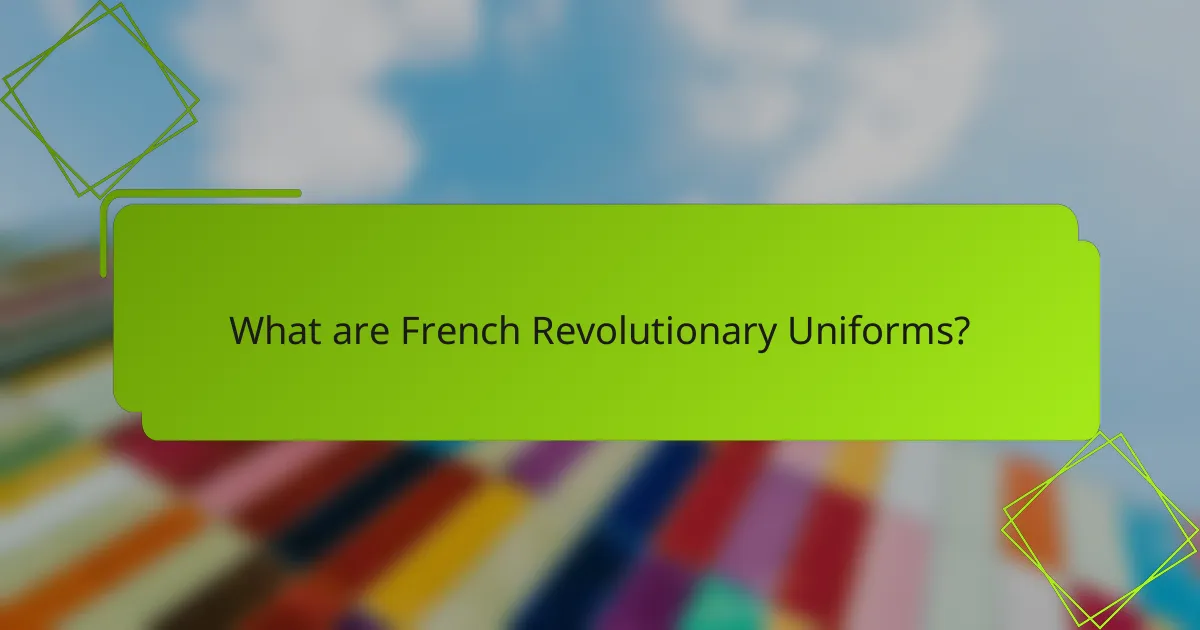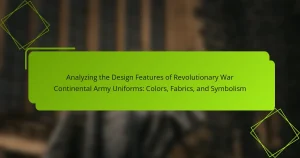French Revolutionary Uniforms were military outfits worn by soldiers during the French Revolution from 1789 to 1799, symbolizing the core revolutionary ideals of liberty, equality, and fraternity. These uniforms featured distinctive colors—blue, white, and red—aligned with the national flag, and included design elements such as cockades and tricolor sashes. The article outlines the evolution of these uniforms across various military branches, including the infantry and cavalry, while highlighting their role in fostering national identity and unity among troops. Additionally, notable examples of uniforms, such as those worn by the National Guard and the French Army, are discussed, emphasizing their cultural impact and influence on modern military aesthetics. Overall, French Revolutionary uniforms serve as iconic representations of the era and its values, extending their significance beyond France to inspire other nations in their revolutionary movements.

What are French Revolutionary Uniforms?
French Revolutionary Uniforms were military outfits worn by soldiers during the French Revolution from 1789 to 1799. These uniforms symbolized the revolutionary ideals of liberty, equality, and fraternity. They featured distinctive colors such as blue, white, and red, reflecting the national flag. The designs often included elements like cockades and tricolor sashes. The uniforms evolved to represent various military branches, including the infantry and cavalry. Historical records indicate that these uniforms played a significant role in unifying troops and fostering national identity. They were also influenced by earlier military styles but adapted to reflect revolutionary sentiments. Ultimately, French Revolutionary Uniforms became iconic representations of the era and its values.
How did the design of French Revolutionary Uniforms evolve?
The design of French Revolutionary uniforms evolved significantly from 1789 to 1799. Initially, the uniforms were based on the traditional styles of the Ancien Régime. These early designs featured elaborate decorations and colors that reflected aristocratic influences. As the Revolution progressed, the focus shifted towards simplicity and practicality. The introduction of the tricolor cockade symbolized national pride and unity. By 1794, military attire adopted more functional elements, such as the short coat and trousers. This change was influenced by the need for mobility in battle. The uniforms also began to incorporate revolutionary symbols, further aligning with the new republican ideals. Overall, the evolution marked a transition from aristocratic to nationalistic designs, reflecting broader social changes during the Revolution.
What historical events influenced the design of these uniforms?
The design of French Revolutionary uniforms was influenced by the political and social upheaval of the late 18th century. The Revolution led to a shift from traditional monarchy to republican ideals. This change was reflected in the adoption of simpler, more practical designs. The influence of the Enlightenment also emphasized reason and equality, impacting uniform aesthetics. Key events, such as the Storming of the Bastille in 1789, symbolized the break from the past. The revolutionary colors of blue, white, and red became emblematic of the new republic. Additionally, military reforms aimed to democratize the army influenced uniform styles. The uniforms represented both a new national identity and a departure from aristocratic traditions.
What were the primary materials used in creating these uniforms?
The primary materials used in creating French Revolutionary uniforms included wool, linen, and cotton. Wool was commonly used for its durability and warmth, especially in coats and trousers. Linen was favored for its breathability, often used in shirts and lighter garments. Cotton became more prevalent later for its comfort and ease of care. These materials were chosen for their availability and practicality during the revolutionary period.
What key design elements characterize French Revolutionary Uniforms?
French Revolutionary uniforms are characterized by their distinctive design elements such as tricolor cockades, simplified cuts, and bold colors. The tricolor cockade, featuring blue, white, and red, symbolized the revolution and national pride. Simplified cuts allowed for greater mobility and practicality in battle. Bold colors, particularly blue and red, were used to signify allegiance and rank. Additionally, the use of epaulettes and braiding reflected military hierarchy and discipline. These design elements collectively represented the revolutionary spirit and the shift towards a more egalitarian military structure.
How do cut and silhouette play a role in the uniform design?
Cut and silhouette significantly influence uniform design by shaping the overall visual impact and functionality. The cut determines how the fabric drapes and fits the body, affecting mobility and comfort. Silhouette defines the outline or shape of the uniform, conveying authority and identity. Historical examples show that military uniforms with structured silhouettes project strength and discipline. In the context of French Revolutionary uniforms, the cut often reflected contemporary fashion trends, merging practicality with style. The use of tailored cuts allowed for ease of movement during combat. Additionally, distinctive silhouettes helped differentiate ranks and roles within the military. Thus, cut and silhouette are essential for both aesthetic appeal and functional effectiveness in uniform design.
What specific insignia and symbols were commonly used?
Common insignia and symbols used in French Revolutionary uniforms included the Phrygian cap and the tricolor cockade. The Phrygian cap represented freedom and was often worn by revolutionaries. The tricolor cockade, featuring blue, white, and red, symbolized the French nation and unity. Other symbols included the laurel wreath, representing victory, and the fasces, symbolizing strength and authority. These insignia were integral to the identity of the Revolutionary forces. The use of these symbols was widespread during the late 18th century, reflecting the values and ideals of the revolution.
What color schemes were prevalent in French Revolutionary Uniforms?
French Revolutionary uniforms predominantly featured blue, white, and red color schemes. These colors symbolized the ideals of liberty, equality, and fraternity. Blue was often used for the coats of soldiers, while white was commonly seen in the trousers. Red was utilized in various accents and details, representing the blood of those who fought for the revolution. The combination of these colors became emblematic of the French Republic. Historical records indicate that these color schemes were officially adopted in the late 18th century. They were also influenced by the tricolor flag established in 1790. This uniform design aimed to unify the soldiers under revolutionary ideals.
What meanings were associated with the colors used in the uniforms?
The colors used in the French Revolutionary uniforms had significant meanings. Blue symbolized freedom and loyalty, aligning with revolutionary ideals. Red represented courage and sacrifice, reflecting the blood shed for liberty. White stood for purity and the hope for a new society. These colors collectively represented the values of the revolution. The tri-color scheme became a national symbol, embodying the principles of liberty, equality, and fraternity. Historical context shows that these colors were adopted to unify the revolutionary forces. The colors were also a visual representation of the break from monarchy and the establishment of a republic.
How did color choices reflect the political climate of the time?
Color choices in French Revolutionary uniforms reflected the political climate by symbolizing revolutionary ideals. The predominant colors were blue, white, and red, representing liberty, equality, and fraternity. These colors were adopted from the French flag, which emerged during the revolution. The use of blue signified loyalty to the republic. White symbolized purity and peace, while red represented the blood of martyrs. Additionally, the shift from royal colors like gold and purple indicated a rejection of monarchy. This transformation in color choices illustrated the societal shift towards republicanism. Historical records show that these colors were used in various military and civic uniforms throughout the revolution. This alignment of color with political sentiment reinforced the revolutionary message to the populace.

What was the cultural impact of French Revolutionary Uniforms?
French Revolutionary uniforms significantly influenced cultural identity and national pride in France. These uniforms symbolized the revolutionary ideals of liberty, equality, and fraternity. The introduction of the tricolor flag as a uniform element fostered a sense of unity among the people. Uniforms also distinguished military personnel from the monarchy, emphasizing a break from the past. The use of specific colors represented the values of the revolution, with blue, white, and red becoming national symbols. Artistic representations of these uniforms in paintings and literature further embedded them in the cultural consciousness. The impact extended beyond France, inspiring other nations in their own revolutionary movements. Overall, French Revolutionary uniforms played a crucial role in shaping modern national identity and military aesthetics.
How did these uniforms influence military fashion in subsequent eras?
French Revolutionary uniforms significantly influenced military fashion in subsequent eras. Their use of bold colors and distinctive designs set new standards for military attire. The introduction of the bicorne hat became a lasting symbol in military headgear. The incorporation of epaulettes established a tradition of rank insignia that persisted in many armies. Tailored cuts and fitted silhouettes influenced the design of uniforms in the 19th century. The emphasis on national colors fostered a sense of identity in military dress. These elements were adopted globally, shaping military uniforms in various countries. Overall, the French Revolutionary uniforms marked a pivotal shift in military fashion that resonated through the ages.
What role did French Revolutionary Uniforms play in shaping national identity?
French Revolutionary uniforms played a significant role in shaping national identity by symbolizing the ideals of the Revolution. These uniforms represented liberty, equality, and fraternity, core values of the French Republic. The use of specific colors, such as blue, white, and red, became emblematic of French nationalism. The adoption of standardized military attire fostered a sense of unity among soldiers and citizens alike. Uniforms also distinguished the revolutionary forces from the monarchy, reinforcing a break from the past. Historical records indicate that uniforms were designed to reflect the revolutionary spirit and promote civic pride. This visual representation helped solidify a collective national identity during a tumultuous period in France.
In what ways did French Revolutionary Uniforms affect social movements?
French Revolutionary uniforms significantly influenced social movements by symbolizing revolutionary ideals and unifying diverse groups. These uniforms often featured tricolor designs, representing liberty, equality, and fraternity. The visual impact of these colors fostered a sense of belonging among revolutionaries. They also distinguished revolutionaries from the monarchy and aristocracy, reinforcing class divisions. The adoption of military-style uniforms inspired various social movements across Europe. For instance, the Napoleonic Wars spread these revolutionary ideals, influencing nationalist movements. The uniforms became a powerful tool for mobilizing citizens and promoting civic identity. They served as a visual representation of the fight for rights and social change during a transformative period in history.
How did the uniforms symbolize revolutionary ideals among the populace?
Uniforms during the French Revolution symbolized revolutionary ideals by embodying the principles of liberty, equality, and fraternity. The colors blue, white, and red represented these ideals, with blue symbolizing liberty, white representing equality, and red signifying fraternity. The adoption of military uniforms also fostered a sense of unity among the populace. These uniforms distinguished revolutionary forces from the monarchy, creating a visual representation of the new order. Additionally, the use of standardized designs promoted a collective identity among revolutionaries. Historical records show that uniforms became a powerful tool for propaganda, reinforcing the revolutionary message to the masses. Thus, uniforms served as both a symbol and a practical means of communicating revolutionary values.
What impact did they have on the perception of the military in society?
French Revolutionary uniforms significantly altered the perception of the military in society. They symbolized a break from traditional military attire, emphasizing equality and civic duty. The introduction of bold colors and distinct designs fostered a sense of national pride. These uniforms were seen as a representation of revolutionary ideals, aligning the military with the populace. The visual transformation contributed to the military’s image as a defender of the people rather than an oppressive force. This shift was crucial in garnering public support for military actions during the revolution. Historical records indicate that these uniforms inspired similar reforms across Europe, influencing military dress in various nations.

What are some notable examples of French Revolutionary Uniforms?
Notable examples of French Revolutionary uniforms include the uniforms of the National Guard and the uniforms of the French Army. The National Guard wore a blue coat with red and white trim, symbolizing the revolutionary colors. The French Army adopted the infantry uniform featuring a blue coat and white trousers. Artillery units sported a similar blue coat but with a distinctive red collar. The cavalry wore a variety of uniforms, often incorporating elements of the infantry design. These uniforms reflected the ideals of liberty and equality during the revolution. The color schemes were intentionally chosen to represent the national flag. The designs evolved throughout the revolution, showcasing the changing political landscape.
Which specific uniforms are considered iconic from this period?
The iconic uniforms from the French Revolutionary period include the blue and white uniform of the National Guard. This uniform symbolized the revolutionary spirit and was widely adopted in 1789. Another notable example is the uniform of the Republican Army, which featured a tricolor cockade. This cockade became a symbol of the revolution and represented liberty, equality, and fraternity. Additionally, the uniform of the sans-culottes, characterized by the absence of knee breeches, reflected the revolutionary ideals of the working class. These uniforms played a crucial role in defining the identity of the revolutionary forces.
What are the distinguishing features of these iconic uniforms?
French Revolutionary uniforms are characterized by their distinct design elements, color schemes, and cultural significance. The use of blue, white, and red reflects the national colors of France. These uniforms often feature high collars and epaulettes, symbolizing military rank and authority. The tricolor cockade became a prominent emblem, representing revolutionary ideals. Additionally, the cut of the uniforms was influenced by both practicality and aesthetics, allowing for ease of movement in battle. The incorporation of symbols like the Phrygian cap signifies liberty and freedom. These uniforms were not only functional but also served to unify soldiers under a common revolutionary cause.
What lessons can be learned from the design of French Revolutionary Uniforms?
The design of French Revolutionary uniforms teaches lessons about symbolism and identity. These uniforms emphasized national pride through colors like blue, white, and red. The colors represented liberty, equality, and fraternity. The use of simpler designs reflected a break from aristocratic fashion. This approach made uniforms more accessible and relatable to the common citizen. The incorporation of military insignia fostered unity and hierarchy within the ranks. Historical context shows that these uniforms played a role in shaping national identity. Overall, the design choices of this era highlight the importance of visual representation in political movements.
How can modern designers draw inspiration from these historical uniforms?
Modern designers can draw inspiration from historical French Revolutionary uniforms by analyzing their key design elements. These uniforms featured bold colors and distinctive silhouettes that conveyed authority and identity. The use of tricolor schemes symbolizes national pride and can influence contemporary color palettes. Textures and materials used in these uniforms can inspire fabric choices in modern fashion. Additionally, the incorporation of military-inspired details can add a sense of structure and formality to modern designs. Historical context, such as the symbolism behind specific elements, provides deeper meaning for contemporary creations. Designers can also explore the innovative tailoring techniques used during that period, adapting them for modern aesthetics. Overall, the blending of historical references with current trends can result in unique fashion statements.
What best practices can be applied when studying historical military fashion?
When studying historical military fashion, it is essential to analyze primary sources such as uniforms, paintings, and military records. These sources provide direct insight into the design and functionality of the attire. Contextualizing the fashion within its historical period is crucial. Understanding the political and social influences of the time can explain design choices.
Comparative analysis is also beneficial. Examining uniforms from different nations or eras can highlight unique features and common trends. Consulting scholarly articles and books written by historians enhances understanding. Resources like “Military Fashion: A History of the Uniform” by John Smith provide valuable context and analysis.
Lastly, visiting museums or collections that specialize in military history allows for firsthand observation of artifacts. This practice can deepen appreciation for materials and craftsmanship used in historical uniforms.
French Revolutionary Uniforms are military outfits worn by soldiers during the French Revolution from 1789 to 1799, symbolizing the ideals of liberty, equality, and fraternity. The article examines their design evolution, key materials, distinctive elements, and color schemes, highlighting the cultural impact these uniforms had on national identity and social movements. It also explores how these uniforms influenced military fashion and the perception of the military in society. Notable examples and iconic features of these uniforms are discussed to illustrate their significance in shaping modern military aesthetics and civic pride.




